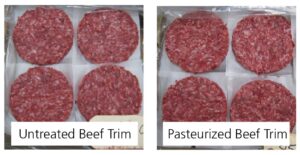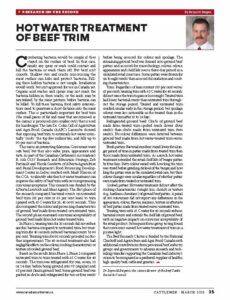Hot Water Treatment of Beef Trim
This article written by Dr. Reynold Bergen, BCRC Science Director, originally appeared in the March 2015 issue of Canadian Cattlemen magazine and is reprinted on the BCRC Blog with permission of the publisher.
Combating bacteria would be simple if they stayed on the surface of beef. In that case, nearly any spray or wash could contact and kill the bacteria or wash them off. But beef isn’t smooth. Shallow cuts and cracks crisscrossing the meat surface can hide and protect bacteria. Killing these hidden bacteria is not simple. Irradiation would work, but isn’t approved for use in Canada yet. Organic acid washes and sprays may not reach the bacteria hidden in these cracks, or the acids may be neutralized by the meat proteins before bacteria can be killed. To kill these bacteria, food safety interventions need to penetrate a short distance into the meat surface. This is particularly important for beef trim (the small pieces of fat and meat that are removed as the carcass is processed into smaller cuts) that is used for hamburger. The late Dr. Colin Gill of AAFC Lacombe showed that exposing beef trim to extremely hot water essentially “cooks” the top few millimeters, and kills up to 90% of bacteria.
This raises an interesting dilemma. Consumers want safe beef, but they also value price, appearance and taste. As part of the Canadian Cattlemen’s Association’s (CCA) E. coli O157 Research and Education Strategy, Zeb Pietrasik and Nicole Gaudette of Alberta Agriculture and Rural Development’s Food Processing Development Center in Leduc worked with Mark Klassen of the CCA to identify whether hot water treatment can improve the safety of beef trim without compromising consumer acceptance. This research was funded by the Alberta Livestock and Meat Agency.The first phase of the research compared bacterial counts on untreated beef trim (65% or 85% lean) to trim sprayed with 85oC water for 20, 40 or 60 seconds. They also compared the color and processing characteristics of ground beef made from treated or untreated trim. The second phase examined consumer acceptability of ground beef made from hot-water treated trim.
In phase 1, treating trim for 20 seconds did not reduce aerobic bacteria compared to untreated trim, but treating trim for 40 seconds reduced bacterial counts by 90%. Treating trim for 60 seconds provided no further improvement. The 40 second treatment also had negligible effects on the color, cooking characteristics or texture of cooked ground beef.
Based on the results from Phase 1, Phase 2 compared untreated trim to trim treated with 85oC water for 40 seconds. The trim was refrigerated for 1, 7, 10 or 14 days before being ground into 70% (regular) and 85% (lean) ground beef. Some ground beef was packed in chubs and refrigerated for 2 or 4 weeks before being assessed for color and spoilage. The remaining ground beef was formed into ground beef patties and assessed for microbiology, color, odor, appearance and shelf life over a 3 day period in a simulated retail meat case. Some patties were frozen for 6 to 8 weeks then assessed for oxidation and cooking characteristics.

Trim: Regardless of lean content (65% vs. 85%), treating trim with 85oC water for 40 seconds did not cause the trim to gain or lose weight. Treated trim had lower bacterial counts than untreated trim throughout the storage period. Treated and untreated trim smelled similar early in the storage period, but spoilage odors were less noticeable in the treated than in the untreated trim after 10 to 14 days.
Refrigerated ground beef: Chubs of ground beef made from treated trim spoiled much slower (4 weeks) than chubs made from untreated trim (2 weeks). No color differences were detected between ground beef from made from hot water treated trim vs. untreated trim.
Fresh patties: Bacterial numbers stayed lower for a longer period of time in patties made from treated trim than those made from untreated trim. As a result, hot water treatment extended the retail shelf life of burger patties by 4 days. Patty color varied with long the trim was stored before grinding, fat level of the burger, and how long the patties were in the simulated retail case, but these color changes were similar regardless of whether patties were made from treated or untreated trim.
Cooked patties: Hot water treatment did not affect the cooking characteristics (weight loss, shrink) or texture (e.g. hardness, chewiness) of ground beef patties. A panel of 300 consumers did not report any differences in the appearance, color, flavor, juiciness, texture or aftertaste of beef patties made from treated vs. untreated trim.
Treating trim with 85oC water for 40 seconds reduces bacterial counts and extends the shelf life of ground beef, with no negative impacts on consumer acceptability of the retail product. Subsequent focus group testing found that consumers viewed hot water treatment of trim in a positive light.
Click here to subscribe to the BCRC Blog and receive email notifications when new content is posted.
The sharing or reprinting of BCRC Blog articles is typically welcome and encouraged, however this article requires permission of the original publisher.
We welcome your questions, comments and suggestions. Contact us directly or generate public discussion by posting your thoughts below.
